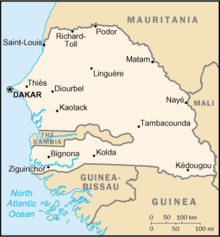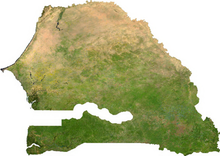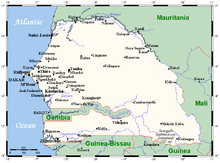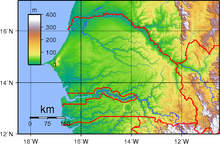- Geography of Senegal
-
Senegal is a coastal West African nation located 14 degrees north of the Equator and 14 degrees west of the Prime Meridian. The country's total area is 196 190 km² of which 192 000 km² is land and 4 190 km² is water, making the nation slightly smaller than Britain or the U.S. state of South Dakota.
Senegal is bordered to the west by the North Atlantic Ocean. On land, the nation's longest border is with Mauritania to the north, an 813 km border along the Senegal River. To the east is the 419 km border with Mali. In the southeast is Guinea (330 km border) and to the southsouthwest is Guinea-Bissau (338 km), both borders running along the Casamance River. Senegal is one of only a handful of countries to have a near-enclave within its borders—the small nation of The Gambia in the interior, which has a 740 km border with Senegal. The Gambia penetrates more than 320 km into Senegal, from the Atlantic coast to the center of Senegal along the Gambia River, which bisects Senegal's territory. In total, Senegal has 2 640 km of land borders, and 531 km of coastline and shoreline. Senegal makes maritime claims of a 24 nmi (44.4 km; 27.6 mi) contiguous zone, a 12 nmi (22.2 km; 13.8 mi) territorial sea, and a 370 km (200 nmi; 230 mi) exclusive economic zone. It also claims a 200 nmi (370.4 km; 230.2 mi) continental shelf, or to the edge of the continental margin.
The lowest point in Senegal is the Atlantic Ocean, at sea level. The highest point is an unnamed feature near Nepen Diakha in the Fouta Djallon foothills at 581 m (1,906 ft)).
Contents
Climate
Tropical; hot, humid; rainy season (May to November) has strong southeast winds; dry season (December to April) dominated by hot, dry, harmattan wind.[1] Well-defined dry and humid seasons result from northeast winter winds and southwest summer winds. Dakar's annual rainfall of about 600 mm (24 in) occurs between June and October when maximum temperatures average 30 °C (86.0 °F) and minimums 24.2 °C (75.6 °F); December to February maximum temperatures average 25.7 °C (78.3 °F) and minimums 18 °C (64.4 °F).[2] Interior temperatures are higher than along the coast (for example, average daily temperatures in Kaolack and Tambacounda for May are 30 °C (86.0 °F) and 32.7 °C (90.9 °F) respectively, compared to Dakar's 23.2 °C (73.8 °F) ),[3] and rainfall increases substantially farther south, exceeding 1,500 mm (59.1 in) annually in some areas. In the far interior of the country, in the region of Tambacounda, particularly on the border of Mali, temperatures can reach as high as 54 °C (129.2 °F).
Vegetation:
Senegal has a number of vegetation zones: sahel, Sahel-Soudan, Sudan_(region), Soudan-Guinea, tropical rainforest, and Guinean mangroves.[4] Most of the southern Casamance arm of the country has been classified by the World Wildlife Fund as part of the Guinean forest-savanna mosaic ecoregion.
Finally, it's worth looking out these 2 last maps, although they include "other zones" as well.
Terrain: generally low, rolling, plains rising to foothills in the southeast.
Natural resources: fish, phosphates, iron ore
Land use:
arable land: 12%
permanent crops: 0%
permanent pastures: 16%
forests and woodland: 54%
other: 18% (1993 est.)Irrigated land: 1,200 km² (2003 est.)
Natural hazards: lowlands seasonally flooded; periodic droughts
Environment - current issues: wildlife populations threatened by poaching; deforestation; overgrazing; soil erosion; desertification; overfishing
Senegal is a party to several environmental treaties:
- Comprehensive Test Ban Treaty
- Convention on Biological Diversity
- Convention on Fishing and Conservation of Living Resources of the High Seas
- Convention on the International Trade in Endangered Species of Wild Flora and Fauna
- International Convention for the Regulation of Whaling
- Montreal Protocol
- United Nations Framework Convention on Climate Change
- United Nations Convention to Combat Desertification
- United Nations Convention on the Law of the Sea
- Ramsar Convention
- 1978 Convention on Ship Pollution
Senegal has signed, but not ratified the Convention on Marine Dumping.
Extreme points
This is a list of the extreme points of Senegal, the points that are farther north, south, east or west than any other location.
- Northern-most point – unnamed location on the border with Mauritania in the Senegal river immediately north-west of the town of Podor, Saint-Louis Region
- Eastern-most point – unnamed location on the border with Mali near the confluence of the Balin-Ko river and the Falémé River, Kédougou Region
- Southern-most point – unnamed location on the border with Guinea immediately south of the village of Toile, Kédougou Region
- Western-most point - Pointe des Almadies, Cap Vert peninsula, Dakar Region*
- *Note: this is the also the western-most point of the African continent
Gallery
References
- ^ CIA factbook
- ^ [1]
- ^ [2]
- ^ http://www.lib.utexas.edu/maps/africa/senegal_gambia_veg_1972.jpg Vegetation zones of Senegal
Sovereign
states- Algeria
- Angola
- Benin
- Botswana
- Burkina Faso
- Burundi
- Cameroon
- Cape Verde
- Central African Republic
- Chad
- Comoros
- Democratic Republic of the Congo
- Republic of the Congo
- Côte d'Ivoire (Ivory Coast)
- Djibouti
- Egypt
- Equatorial Guinea
- Eritrea
- Ethiopia
- Gabon
- The Gambia
- Ghana
- Guinea
- Guinea-Bissau
- Kenya
- Lesotho
- Liberia
- Libya
- Madagascar
- Malawi
- Mali
- Mauritania
- Mauritius
- Morocco
- Mozambique
- Namibia
- Niger
- Nigeria
- Rwanda
- São Tomé and Príncipe
- Senegal
- Seychelles
- Sierra Leone
- Somalia
- South Africa
- South Sudan
- Sudan
- Swaziland
- Tanzania
- Togo
- Tunisia
- Uganda
- Zambia
- Zimbabwe
States with limited
recognition- Sahrawi Arab Democratic Republic
- Somaliland
Dependencies and
other territories- Canary Islands / Ceuta / Melilla / Plazas de soberanía (Spain)
- Madeira (Portugal)
- Mayotte / Réunion (France)
- Saint Helena / Ascension Island / Tristan da Cunha (United Kingdom)
- Western Sahara
Climate of Africa Sovereign
states- Algeria
- Angola
- Benin
- Botswana
- Burkina Faso
- Burundi
- Cameroon
- Cape Verde
- Central African Republic
- Chad
- Comoros
- Democratic Republic of the Congo
- Republic of the Congo
- Côte d'Ivoire (Ivory Coast)
- Djibouti
- Egypt
- Equatorial Guinea
- Eritrea
- Ethiopia
- Gabon
- The Gambia
- Ghana
- Guinea
- Guinea-Bissau
- Kenya
- Lesotho
- Liberia
- Libya
- Madagascar
- Malawi
- Mali
- Mauritania
- Mauritius
- Morocco
- Mozambique
- Namibia
- Niger
- Nigeria
- Rwanda
- São Tomé and Príncipe
- Senegal
- Seychelles
- Sierra Leone
- Somalia
- South Africa
- South Sudan
- Sudan
- Swaziland
- Tanzania
- Togo
- Tunisia
- Uganda
- Zambia
- Zimbabwe
States with limited
recognition- Sahrawi Arab Democratic Republic
- Somaliland
Dependencies and
other territories- Canary Islands / Ceuta / Melilla / Plazas de soberanía (Spain)
- Madeira (Portugal)
- Mayotte / Réunion (France)
- Saint Helena / Ascension Island / Tristan da Cunha (United Kingdom)
- Western Sahara
Categories:
Wikimedia Foundation. 2010.








